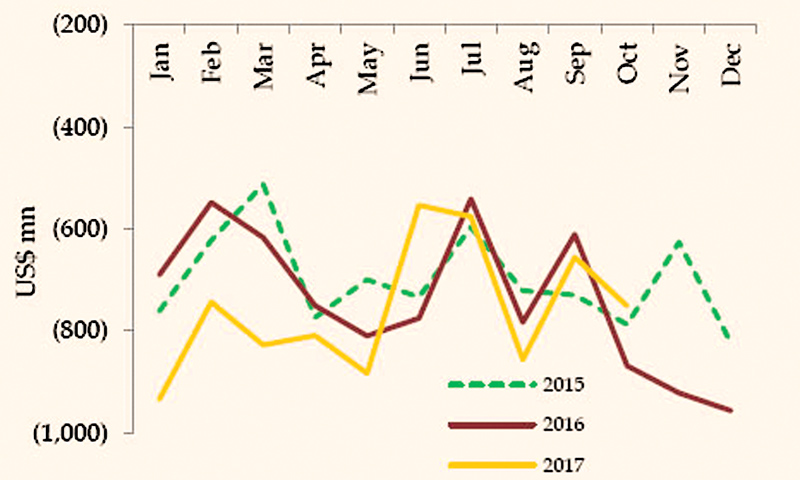The external sector exhibited a significant improvement in October 2017, with a notable decline in the trade deficit and continued inflows to the financial account of the Balance of Payment (BOP).
Higher export earnings, which recorded a double digit growth for the fourth consecutive month, and a deceleration in import expenditure resulted in a significant year-on-year decline in the trade deficit in October.
However, earnings from tourism increased moderately, while workers’ remittances further declined, owing to adverse economic and geopolitical conditions prevailing in the Middle Eastern region.
Inflows to the financial account of the BOP continued during the month amidst increased foreign investments in the Colombo Stock Exchange (CSE) and the government securities market.
Reflecting these developments, the BOP recorded an overall surplus of around US dollars 2.0 billion by end October 2017. Meanwhile, the level of gross official reserves increased to US dollars 7.5 billion at end October 2017, particularly with the absorption of foreign currency liquidity from the domestic foreign exchange market by the Central Bank.
The deficit in the trade account contracted in October 2017 in comparison to the corresponding period of the previous year mainly due to the healthy performance in export earnings. However, the cumulative trade deficit expanded at a moderate rate during the first ten months of 2017. Expenditure on imports decelerated in October 2017 mainly due to the decline in expenditure on sugar imports owing to lower prices as well as lower volumes.
Comparatively high imports in October 2016 also impacted on the year-on-year growth of sugar imports.
Fuel imports declined as a result of low crude oil imports in volumes despite an increase in prices.
Import expenditure on investment goods declined due to lower imports of machinery and equipment led by telecommunication devices and transport equipment. There was also a decline in imports of auto trishaws and lorries.
Expenditure on construction sector related imports showed a mixed performance as building materials led by cement imports declined, while imports of iron and steel of both finished and raw forms as well as cement clinkers increased in October 2017.
However, continuing the higher increase observed since January 2017 in view of measures taken to fulfill the shortage of rice in the domestic market, volume of rice imports increased by 2,433.6 per cent in October 2017 on a year-on-year basis.
Increased clothing and footwear imports mainly contributed to the growth in imports of clothing and accessories. India, China, UAE, Singapore and Japan were the main import origins accounting for about 59 percent of total imports in October 2017.
In October 2017, tourist arrivals recorded a marginal increase in comparison to October 2016, while earnings from tourism also increased marginally during the month. The top five sources of tourist arrivals, namely; India, China, the UK, Germany and France accounted for 52.4 percent of total tourist arrivals up to end October 2017.
On a cumulative basis, tourist arrivals and earnings from tourism increased during the first ten months of 2017 compared to the corresponding period of 2016. Meanwhile, workers’ remittances continued to decline significantly by 12.2 percent during October 2017, as a result of adverse economic and geopolitical conditions prevailing in the Middle Eastern region. Accordingly, workers’ remittances declined by 7.9 percent (year-on-year) on a cumulative basis during the year up to end October 2017.
The financial account of the BOP continued to strengthen during the month of October 2017. Reflecting positive investor sentiment, the CSE marked a substantial net inflow (including both secondary and primary market foreign exchange flows) in October 2017 and during the first ten months in comparison to the net outflow recorded during the corresponding period in 2016. Foreign investments to the government securities market witnessed net inflows for the eighth consecutive month. Meanwhile, long-term loans to the government increased on a net basis during the first ten months of the year.



Add new comment